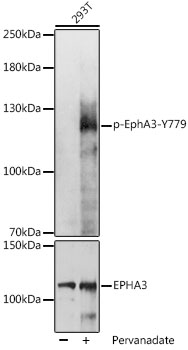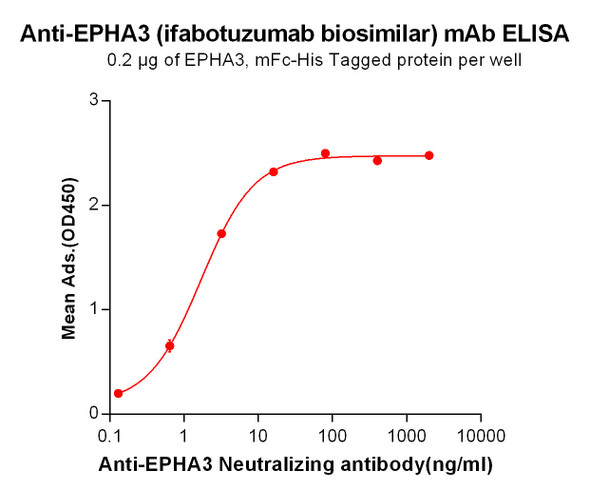Cell Biology Antibodies 14
Anti-Phospho-EphA3-Y779 Antibody (CABP1056)
- SKU:
- CABP1056
- Product Type:
- Antibody
- Reactivity:
- Human
- Host Species:
- Rabbit
- Isotype:
- IgG
- Antibody Type:
- Polyclonal Antibody
- Research Area:
- Cell Biology
Description
| Antibody Name: | Anti-Phospho-EphA3-Y779 Antibody |
| Antibody SKU: | CABP1056 |
| Antibody Size: | 20uL, 50uL, 100uL |
| Application: | WB |
| Reactivity: | Human |
| Host Species: | Rabbit |
| Immunogen: | A phospho synthetic peptide corresponding to residues surrounding Y779 of human EphA3. |
| Application: | WB |
| Recommended Dilution: | WB 1:500 - 1:2000 |
| Reactivity: | Human |
| Positive Samples: | 293T |
| Immunogen: | A phospho synthetic peptide corresponding to residues surrounding Y779 of human EphA3. |
| Purification Method: | Affinity purification |
| Storage Buffer: | Store at -20°C. Avoid freeze / thaw cycles. Buffer: PBS with 0.02% sodium azide, 50% glycerol, pH7.3. |
| Isotype: | IgG |
| Sequence: | Email for sequence |
| Gene ID: | 2042 |
| Uniprot: | P29320 |
| Cellular Location: | Cell membrane, Secreted, Single-pass type I membrane protein |
| Calculated MW: | 110kDa |
| Observed MW: | 110kDa |
| Synonyms: | EK4, ETK, HEK, ETK1, HEK4, TYRO4, EPHA3 |
| Background: | This gene belongs to the ephrin receptor subfamily of the protein-tyrosine kinase family. EPH and EPH-related receptors have been implicated in mediating developmental events, particularly in the nervous system. Receptors in the EPH subfamily typically have a single kinase domain and an extracellular region containing a Cys-rich domain and 2 fibronectin type III repeats. The ephrin receptors are divided into 2 groups based on the similarity of their extracellular domain sequences and their affinities for binding ephrin-A and ephrin-B ligands. This gene encodes a protein that binds ephrin-A ligands. Two alternatively spliced transcript variants have been described for this gene. |
| UniProt Protein Function: | EphA3: a receptor tyrosine kinase of the Eph family. Receptor for members of the ephrin-A family: binds to ephrin-A2, -A3, -A4 and -A5The Eph receptor tyrosine kinase family, the largest in the tyrosine kinase group, has fourteen members. They bind membrane-anchored ligands, ephrins, at sites of cell-cell contact, regulating the repulsion and adhesion of cells that underlie the establishment, maintenance, and remodeling of patterns of cellular organization. Eph signals are particularly important in regulating cell adhesion and cell migration during development, axon guidance, homeostasis and disease. EphA receptors bind to GPI-anchored ephrin-A ligands, while EphB receptors bind to ephrin-B proteins that have a transmembrane and cytoplasmic domain. Interactions between EphB receptor kinases and ephrin-B proteins transduce signals bidirectionally, signaling to both interacting cell types. Eph receptors and ephrins also regulate the adhesion of endothelial cells and are required for the remodeling of blood vessels. Two point mutations seen in a survey of colorectal tumors. Soluble receptors reduce tumor growth and angiogenesis in mouse models. Two alternatively spliced isoforms of EphA3 have been described. |
| UniProt Protein Details: | Protein type:EC 2.7.10.1; Protein kinase, tyrosine (receptor); Protein kinase, TK; Membrane protein, integral; Kinase, protein; TK group; Eph family Chromosomal Location of Human Ortholog: 3p11.2 Cellular Component: early endosome; extracellular region; integral to plasma membrane; plasma membrane Molecular Function:ATP binding; GPI-linked ephrin receptor activity; protein binding Biological Process: cell adhesion; cell migration; ephrin receptor signaling pathway; peptidyl-tyrosine phosphorylation; regulation of actin cytoskeleton organization and biogenesis; regulation of focal adhesion formation; regulation of GTPase activity |
| NCBI Summary: | This gene belongs to the ephrin receptor subfamily of the protein-tyrosine kinase family. EPH and EPH-related receptors have been implicated in mediating developmental events, particularly in the nervous system. Receptors in the EPH subfamily typically have a single kinase domain and an extracellular region containing a Cys-rich domain and 2 fibronectin type III repeats. The ephrin receptors are divided into 2 groups based on the similarity of their extracellular domain sequences and their affinities for binding ephrin-A and ephrin-B ligands. This gene encodes a protein that binds ephrin-A ligands. Two alternatively spliced transcript variants have been described for this gene. [provided by RefSeq, Jul 2008] |
| UniProt Code: | P29320 |
| NCBI GenInfo Identifier: | 116241351 |
| NCBI Gene ID: | 2042 |
| NCBI Accession: | P29320.2 |
| UniProt Secondary Accession: | P29320,Q9H2V3, Q9H2V4, |
| UniProt Related Accession: | P29320 |
| Molecular Weight: | 60,946 Da |
| NCBI Full Name: | Ephrin type-A receptor 3 |
| NCBI Synonym Full Names: | EPH receptor A3 |
| NCBI Official Symbol: | EPHA3 |
| NCBI Official Synonym Symbols: | EK4; ETK; HEK; ETK1; HEK4; TYRO4 |
| NCBI Protein Information: | ephrin type-A receptor 3 |
| UniProt Protein Name: | Ephrin type-A receptor 3 |
| UniProt Synonym Protein Names: | EPH-like kinase 4; EK4; hEK4; HEK; Human embryo kinase; Tyrosine-protein kinase TYRO4; Tyrosine-protein kinase receptor ETK1; Eph-like tyrosine kinase 1 |
| Protein Family: | Ephrin type-A receptor |
| UniProt Gene Name: | EPHA3 |
| UniProt Entry Name: | EPHA3_HUMAN |







